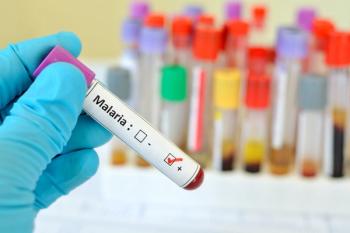Pharmacy Practice in Focus: Oncology
- August 2025
- Volume 7
- Issue 6
Implementing Glofitamab-GemOx in Practice: STARGLO Insights
Glofitamab-GemOx improves survival in transplant-ineligible patients with R/R DLBCL.
The phase 3 STARGLO trial (NCT04408638) demonstrated that glofitamab (Columvi; Genentech)—a CD20 × CD3 bispecific antibody—in combination with gemcitabine (Gemzar; Eli Lilly and Company) and oxaliplatin (GemOx) significantly improved survival outcomes in transplant-ineligible patients with relapsed/refractory diffuse large B-cell lymphoma (R/R DLBCL). This combination is an off-the-shelf fixed-duration regimen, which is an additional treatment option distinguishing it from chimeric antigen receptor (CAR) T-cell therapies and other cellular products that require specialized settings.1 For oncology pharmacists, the integration of this regimen into clinical practice requires attention to treatment sequencing, infusion planning, premedication, supportive care, and close toxicity monitoring. Herein, we highlight sections of the STARGLO study protocol that are important to consider when operationalizing glofitamab-GemOx.
STARGLO Trial Overview
Study Design and Population
STARGLO was a global, randomized, open-label, phase 3 trial enrolling 274 patients across 62 centers in 13 countries. Eligible participants were adults (≥ 18 years) with histologically confirmed R/R DLBCL who had received 1 or more prior systemic therapy and were deemed ineligible for autologous stem cell transplantation.1 Patients were randomly assigned 2:1 to either of the following1:
• Experimental arm: Glofitamab plus GemOx (glofit-GemOx) plus pretreatment with obinutuzumab (Gazyva; Genentech)
• Control arm: Rituximab plus GemOx (R-GemOx)
The primary end point was overall survival (OS), with secondary end points including progression-free survival (PFS), objective response rate (ORR), and safety1 :
• OS: Median OS (presented at American Society of Clinical Oncology/European Hematology Association/International Conference on Malignant Lymphoma in 2025) at 24.7-month follow-up was 13.5 (7.9-18.5) vs not evaluable (19.2-not evaluable) for R-GemOx vs glofit-GemOx (HR, 0.59; P = .011), respectively, with a cutoff date of June 17, 2024.2
• PFS: Glofit-GemOx achieved a 63% reduction in risk of progression or death (HR, 0.37; P < .0001), with a median PFS for glofit-GemOx vs R-GemOx at 13.8 vs 3.6 months (HR, 0.41; 95% CI, 0.29-0.58), respectively.
• Cytokine release syndrome (CRS) incidence: 44% of patients receiving glofitamab experienced CRS, predominantly grades 1 to 2.
Treatment Schedule and Administration
Glofitamab-GemOx is administered in 21-day cycles, with a total of 8 cycles of combination therapy followed by 4 cycles of glofitamab monotherapy, resulting in a total of 12 doses of glofitamab. Patients receive step-up dosing of glofitamab in cycle 1, preceded by obinutuzumab pretreatment to reduce the risk of CRS. The administration order of medications and specific timing are essential to minimize toxicities and ensure efficacy.1-4
Key Points:
• Cycle length: 21 days
• Total treatment duration: Up to 12 cycles (8 cycles of glofitamab + GemOx, 4 cycles of glofitamab alone)
• Cycle 1 day 1: Obinutuzumab 1000 mg intravenous (IV) only (step-up pretreatment)
Obinutuzumab infusion may be split into 2 days for patients at a high risk for an infusionrelated reaction (IRR) (eg, high tumor burden, high peripheral lymphocyte count) or in the event of an IRR
• Cycle 1 day 2: Gemcitabine 1000 mg/m² IV, followed by oxaliplatin 100 mg/m² IV.
• Cycle 1 days 8 and 15: Glofitamab 2.5 mg (day 8) and 10 mg (day 15) IV, with a 90-minute observation period post glofitamab on C1D8, C1D15, and C2D1; from C3D1 onward, for patients who tolerated previous infusions without cytokine release syndrome (CRS) or signs/symptoms of CRS, the observation window could be shortened. Hospitalization is recommended for CRS monitoring with C1D8 and subsequent doses in the event of grade ≥ 2 CRS.
• Cycles 2-8: Glofitamab 30 mg IV (day 1) and gemcitabine 1000 mg/m² IV, followed by oxaliplatin 100 mg/m² IV; GemOx may be given on day 1 or 2, depending on infusion duration and local practice.
• Cycles 9-12: Glofitamab 30 mg IV (day 1).
• Infusion order: Glofitamab should be given before GemOx in cycles 2 through 8
• Infusion extension: Glofitamab may be infused for up to 8 hours in patients at high risk for CRS.
Dose Adjustments and Treatment Interruptions
The STARGLO protocol allowed for dose reductions and scheduling flexibility to manage toxicities, particularly for cytopenias and oxaliplatin-related adverse effects. Pharmacists should verify platelet and neutrophil thresholds before administering each cycle and adapt the sequence or timing of GemOx if required.3,4
Key Points:
• Platelet threshold for GemOx: ≥ 75,000/μL
• Absolute neutrophil count threshold: ≥ 1000/μL
• Oxaliplatin dose reduction: Reduce to 75 mg/ mÇ (25%) for neurotoxicity or hematologic toxicity
• GemOx timing: May be administered on day 1 or 2, based on glofitamab infusion length
• Glofitamab reinitiation: If 7-day or longer delay during step-up, resume at last tolerated dose
Premedications and Supportive Care
Premedications reduce the risk of infusion-related reactions and CRS. Pharmacists should ensure pretreatment with corticosteroids, antihistamines, and antipyretics before obinutuzumab and glofitamab. Growth factor support and infection prophylaxis are also critical, especially during myelosuppressive GemOx cycles.1,3,4
Key Points:
• Premedications before obinutuzumab:
° IV glucocorticoid: dexamethasone 20 mg or methylprednisolone 80 mg
° Acetaminophen 650-1000 mg
° Antihistamine (eg, diphenhydramine 50 mg)
• Premedications before glofitamab:
° Dexamethasone 20 mg IV
° Dexamethasone premedication was optional for patients who tolerated 2 doses of glofitamab 30 mg without CRS
° Acetaminophen 500-1000 mg
° Antihistamine (eg, diphenhydramine 50 mg)
• Emetogenicity:
° Obinutuzumab: minimal
° Glofitamab: minimal
° Gemcitabine: low
° Oxaliplatin: moderate
° Note: Dexamethasone is administered as premedication for glofitamab in C1D8, C1D15, C2D1, and C3D1 and may be administered in subsequent cycles for patients who experienced any CRS with the previous dose.
• Tumor lysis syndrome (TLS) prophylaxis:
° All patients recommended to be well hydrated (eg, approximately 2-3 L/day)
° Evaluate patients for TLS risk, and for those with high tumor burden or risk of TLS, implement the following:
· Allopurinol 300 mg orally daily
· Rasburicase 6 mg IV (optional)
• Granulocyte-colony stimulating factor (G-CSF):
° Primary prophylaxis with G-CSF was recommended with cycles 1 and 2 of GemOx treatment
° For cycles 3 to 8, use of G-CSF was optional for patients who did not have therapy delays due to neutropenia
• Anti-infective prophylaxis:
° Anti-infective prophylaxis for viral, fungal, bacterial, or Pneumocystis infections is permitted and should be instituted per institutional practice or investigator preference based on individual patient risk factors. Patients in countries where prophylactic antiviral medications for hepatitis B reactivation are the standard of care may be treated prophylactically.
Prohibited or Restricted Medications
To minimize toxicity and confounding immunomodulation, the STARGLO protocol prohibited certain medications during and after treatment. Pharmacists should screen for interactions and ensure compliance with these restrictions.1
Key Point:
• Prohibited therapies:
° Live vaccines during treatment and for 6 months post-treatment
Drug-Drug Interactions
Glofitamab’s immunomodulatory activity raises the potential for interactions with other immunosuppressants, anti-infectives, and hepatically metabolized drugs. While glofitamab is not a strong CYP inducer or inhibitor, pharmacists should remain vigilant for overlapping toxicity risks.3
Key Points:
• Monitor drugs prolonging QT interval with administration of oxaliplatin
• Assess renal function for oxaliplatin/gemcitabine dosing adjustments
Treatment Monitoring Requirements
Regular clinical and laboratory assessments are critical for the safe administration of glofitamab-GemOx. Pharmacists should help establish monitoring protocols that include monitoring for infection, CRS tracking, and early recognition of immune effector cell–associated neurotoxicity syndrome (ICANS) or other immune-related events.1-4
Conclusion
The STARGLO trial represents a pivotal advancement in the treatment landscape for transplant-ineligible patients with R/R DLBCL. Glofitamab GemOx not only demonstrated a significant survival benefit compared with R-GemOx but also established a practical alternative to CAR T-cell therapies. Its fixed-duration design, coupled with its off-the-shelf availability and manageable safety profile, positions it as a feasible option for patients who may otherwise have limited access to CAR T-cell therapies.
For oncology pharmacists, the successful implementation of this regimen requires detailed understanding of sequencing available treatment options, optimizing supportive care, and monitoring and management of CRS and ICANS. Given the regimen’s complexity and potential for immune-related toxicities, pharmacist involvement is essential for ensuring patient safety, optimizing therapeutic outcomes, and supporting operational coordination across the clinic, infusion center, and inpatient care teams. As glofitamab-based regimens become more integrated into clinical practice, pharmacy teams will continue to play a leading role in their safe, effective, and equitable delivery.
REFERENCES
Abramson JS, Ku M, Hertzberg M, et al. Glofitamab plus gemcitabine and oxaliplatin (GemOx) versus rituximab-GemOx for relapsed or refractory diffuse large B-cell lymphoma (STARGLO): a global phase 3, randomised, open-label trial. Lancet. 2024;404(10466):1940-1954. doi:10.1016/S0140-6736(24)01774-4
Abramson JS, Ku M, Hertzberg M, et al. Glofitamab plus gemcitabine and oxaliplatin (Glofit-GemOx) in patients (pts) with relapsed/refractory (R/R) diffuse large B-cell lymphoma (DLBCL): 2-year (yr) follow-up of STARGLO. J Clin Oncol. 2025;43(suppl 16). doi:10.1200/JCO.2025.43.16_suppl.7015
FDA Advisory Committee Briefing Document: Columvi (glofitamab-gxbm) plus GemOx. FDA Oncologic Drugs Advisory Committee. May 20, 2025. Accessed July 25, 2025.
https://www.fda.gov/media/186525/download Abramson JS, Ku M, Hertzberg M, et al. Glofitamab plus gemcitabine and oxaliplatin (GemOx) versus rituximab-GemOx for relapsed or refractory diffuse large B-cell lymphoma (STARGLO): a global phase 3, randomised, open-label trial. Lancet. 2024;404(10466):1940-1954. doi:10.1016/S0140-6736(24)01774-4
Articles in this issue
Newsletter
Stay informed on drug updates, treatment guidelines, and pharmacy practice trends—subscribe to Pharmacy Times for weekly clinical insights.





